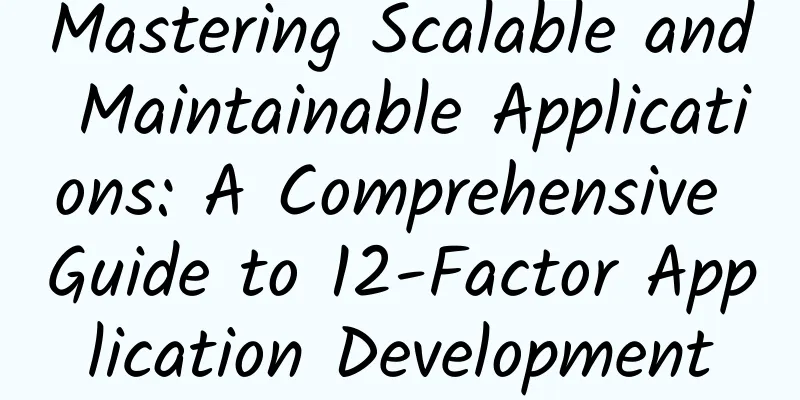Mastering Scalable and Maintainable Applications: A Comprehensive Guide to 12-Factor Application Development

|
1*vhxOhTuKSyuuAKu-nUQ5SA.jpeg In today's fast-paced world, software developers need to create applications that are scalable, maintainable, and adaptable. The 12-Factor Application Methodology is a set of best practices that can help developers achieve these goals. This article dives into the 12 factors, explaining in detail why they are important and how to apply them to your own applications. By following these principles, you can create software that is more reliable, more efficient, and easier to manage. 1. CodebaseThis factor is probably one of the most widely known and simplest of the 12 factors, but it has a significant impact on the development process. Having all the code in one place allows everyone on the team to work from the same source of truth. This simplifies tracking changes, collaboration, and conflict avoidance. There are many benefits to having a single code base. Here are some examples:
0*QYUcsDdE0q6LhCnr.jpeg If you have experience with microservices architecture, you might wonder why this practice is not followed there. However, this is not the case. In a microservices architecture, each service is an independent application, so each service must comply with the 12-Factor development principle. That's why we create separate repositories for each service. 2. DependenciesEven a developer who is just getting started might have a thing about library dependencies. There are many libraries to choose from for different needs, which is why we usually install them without a second thought, not knowing the confusion it might bring. This factor emphasizes the importance of clearly declaring and isolating dependencies. This means that you should specify the exact versions of the libraries and packages that your application depends on. You should also isolate dependencies to ensure that they do not affect each other. 0*z7NYskfvg-CDZDlQ.jpeg Clearly declaring and isolating dependencies is important for several reasons.
The recent Log4j vulnerability is a good example of the importance of managing dependencies. Log4j is a widely used logging library used by many applications. The vulnerability allowed an attacker to execute arbitrary code on the system where Log4j was used. This could have been avoided if the developers of the affected applications had managed their dependencies and updated Log4j to the latest/secure version. 3. ConfigurationStoring configuration settings in environment variables is a key practice that enhances security, flexibility, and portability. Hardcoding configuration values in your code can make your application rigid and vulnerable to security risks. By centralizing configuration in environment variables, you can easily change settings without modifying your code. This makes your application more flexible and portable, and helps improve security. Here is a more detailed explanation of the benefits of storing configuration settings in environment variables: Security: Environment variables are a way to store configuration data outside of your code. This is useful for storing sensitive information, such as passwords and API keys, so that they are not exposed to the public. Storing your API keys and passwords in environment variables is relatively safe, and even now, it is still widely used, but there are more secure options available. Here are the different ways to store your API keys and passwords, from least secure to most secure:
The last three options are relatively similar in that they all use encryption and other security measures to protect your secrets. The main difference between them is how they are managed. Object storage is managed by the cloud provider, while secret managers are typically managed by the application or organization that uses them. People also often use provider-managed secret managers like AWS/GCP Secrets Manager. Ultimately, the option that's best for you will depend on your specific needs and requirements and your organizational data policies. If you need to store sensitive information in a secure manner, then I recommend using a secret manager.
4. Backup servicesModern applications often depend on external services such as databases, caching systems, and message queues. The fourth factor requires that we treat these services as additional resources. This means that your application should connect to these services using configuration settings rather than hard-coding them into the code. This decoupling gives you a lot of flexibility. You can easily replace or scale these services without changing the application's code base. This is very important for cloud-native applications, as they are often deployed and scaled dynamically. 0*iuE-UVATJWbuTXtV.jpeg Here's an example of how this might work in practice. Let's say your application uses a database to store data. The fourth factor would dictate that you shouldn't hardcode the database connection string into your application's code. Instead, you should store the connection string in a configuration file. When the application starts, it will read the connection string from the configuration file and connect to the database. This way, if you need to change the database your application uses, you only need to update the configuration file. You don't need to make any changes to your application's code base. While this example is very simple, you will be able to take full advantage of this principle when building systems that others will use as a platform. Rather, it is the people who will benefit from this principle because they are the ones who can consume your API. 5. Build, Release, RunThis factor is considered a standard practice for any modern service being developed today and dictates that the build, release, and run phases of an application should be strictly separated. The build phase converts your code into executable artifacts, the release phase combines these artifacts with configuration, and the run phase starts the application. This separation ensures that your application can be deployed and run in any environment, regardless of the constraints of the underlying infrastructure. It also makes it easier to automate the deployment process, which helps improve consistency and repeatability. While this is a common practice, one thing that is often overlooked is the separation of the build and release steps. This separation is very important to create a sane deployment and rollback process. When code is merged and tested, the resulting images or binaries should be stored in a repository/factory that can be retrieved later for release and deployment. This separation allows for a simpler, less error-prone development cycle. At a smaller scale or early in the development cycle, when code and infrastructure changes are tightly coupled, this separation may not be necessary. But as your application grows and matures, separating these concerns becomes increasingly important. Here are some concrete examples of implementing the fifth factor in your app:
6. ProcessThe whole point of this factor is to make your application stateless, which means your application should not store any data in memory or on disk. This makes them more scalable and fault-tolerant than stateful processes. Scalability refers to the ability of an application to handle increasing traffic. Stateless processes are scalable because they can be easily replicated. When traffic increases, you simply add more stateless processes to handle the load. A number of scaling issues that any system faces are issues of managing and storing state. This is extremely important for scaling in a software-as-a-service model. This also aligns very well with the concept of bounded contexts, which ensure that each system should manage its storage layer, and if other systems need to access that data, it should be accessed through a well-documented API. Fault tolerance refers to the ability of an application to continue running even when some of its components fail. Stateless processes are fault tolerant because they do not rely on any shared state. If a stateless process fails, other processes can continue to run without interruption. If you haven't noticed yet, this factor is the foundation of the REST API. 0*gAMmnbTGJKBI_B9w.jpeg 7. Port BindingThe seventh factor advocates using well-defined ports to export services. This makes communication between applications easier and also makes it easier for administrators to manage applications. This factor has been standard practice for a long time and nothing has changed. In addition, many containerization standards, proxies, and load balancers already enforce this factor. The main idea is that each application should have a specific port mapping. This means that each application should listen for incoming requests on a specific port. Port numbers can be used to convey information about an application, such as the type of service it provides. For example, a web server might listen for requests on port 80, while an SSH server might listen for requests on port 22. 0*31lCtHojS36AKQMb.jpeg 8. ConcurrencyThe eighth factor advocates using concurrency to handle increasing loads. In this context, concurrency refers to the ability of an application to run multiple instances simultaneously. Stateless applications are the best type of applications for maximum scalability. You can easily group all these processes under a load balancer. For example, in an e-commerce application, all order services will be grouped under one load balancer, and product services will be grouped under another load balancer. 0*-4_ZY8fJtpJp7zOp.jpeg I’m sure you’ve noticed the increasing redundancy in each factor, this is because one factor is an extension of or builds upon the previous one. 9. DisposabilityTo understand disposables, imagine being able to replace a failed portion of your application without having to shut down the entire application. This will allow you to keep your application running smoothly when problems occur. Fast startup and graceful shutdown are critical to application robustness. This is an important factor that is often overlooked when it is needed. Boot checks are important to ensure that the system is running and functioning properly. Health checks ensure that the system remains in this state or is removed from rotation. 0*whae5tSZTQZrU54I.jpeg I often see that the shutdown process is not given the same attention. People often say that it is "relatively complex and difficult to do correctly" or that "if we don't do it cleanly, it won't matter because the system won't survive." ” This statement is incorrect. An important part of the ninth factor is to ensure that the shutdown process is clean and complete so that applications can be quickly started and shut down when necessary. 10. Equality of development and productionThis factor advocates that your development and production environments should be as similar as possible. This can be achieved by using the same tools, the same configuration, and the same settings. 0*XLrJ4s8HrOi9i9uk.jpeg By maintaining this similarity, you can ensure that it is easier to move applications between development, test, and production environments. This also helps avoid the "works on my machine" problem, as differences between development and production environments can cause an application to run well in one environment but fail in another. In actual implementation, the development and production environments will not be exactly the same because their goals and requirements are different. However, they should be as similar as possible to ensure smooth deployment and operation. 11. LogsIn this factor, we stressed the importance of logging. Applications should generate detailed logs to facilitate troubleshooting and diagnosis when problems occur. Logging is a critical monitoring and troubleshooting tool. By reviewing the logs, you can understand the state, performance, and problems of your application. In a production environment, it is very important to have a reliable logging system. 0*FXByK4kn-xHrzx_O.jpeg Here are some best practices for logging:
12. Management ProcessThe last factor highlights the importance of managing application processes. This includes starting, stopping, and scaling processes. Managing processes is a critical part of ensuring that your application runs stably. 0*OUbq8KmZ7504tKtc.jpeg Managing processes often requires some automation tools to ensure they can be started and stopped easily. This may include using container orchestration tools such as Kubernetes or Docker Swarm to automate the deployment and scaling of processes. Ensuring that your application has good management processes in place is extremely important as it reduces the operational burden of ensuring that the application can scale to meet the load when needed. SummarizeThe 12-Factor application methodology provides a set of best practices to help developers build scalable, maintainable, and efficient applications. These factors cover all aspects of the application, from code base and dependency management to configuration, building, publishing, and running. By following these principles, you can create more robust, maintainable, and scalable applications while improving development and operations efficiency. These factors are extremely valuable whether you are developing a monolithic application or building cloud-native microservices. Hopefully, this post has helped you better understand the 12-Factor Application Methodology and apply these best practices in your own projects. |
<<: iOS 17 battery life test is here, and it crashes
>>: iOS 17.0.1 battery life test results are out, and it crashes again!
Recommend
Learn Swift from scratch in 30 days
[[149602]] To be exact, I started learning Swift ...
Scary! Vegetables tied with tape are toxic, with formaldehyde exceeding the standard by 10 times?
Expert of this article: Huang Shan, Deputy Direct...
3 steps to event planning and promotion!
The author summarizes the "three-part theory...
Microphone in the universe: Why do scientists want to listen to the sounds of alien worlds?
NASA's Perseverance rover, currently working ...
User operation: operation skills and channel establishment for user feedback
In operational work, there is a position that req...
The most comprehensive guide to short video distribution on Tik Tok, Kuaishou, etc.!
In the Internet age, short videos are king. 2018 ...
From the perspective of employees: What are the 4 roles a CEO should play?
I wrote an article before, "Nine Characteris...
Can sheep eat meat? Check out the weird behaviors of "eating a sheep"!
Copy review: Ran Hao, a well-known popular scienc...
What advertising resources does Meitu have?
After the full opening of Meitu Information Flow,...
The feat of conquering the moon: the four major challenges and technological breakthroughs facing my country's manned lunar landing
my country has announced its goal of achieving it...
Is the gorilla a terrifying King Kong? No, it is a gentle giant
Enter the Natural History Museum, walk under the ...
PPT skills for event planning with a million-dollar budget!
As long as you pay attention to the following poi...
Lovely owls? It turns out this mysterious species is not simple!
Owls have fascinated humans for thousands of year...
Thousand sheets, bean curd sheets, vegetarian chicken… How do Chinese people make use of soybeans?
Winter is here, and it's time to eat hot pot....
How can a product achieve viral popularity?
Internet screen-sweeping phenomena emerge in an e...









